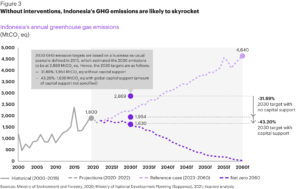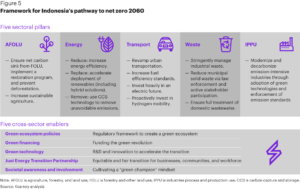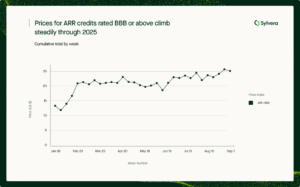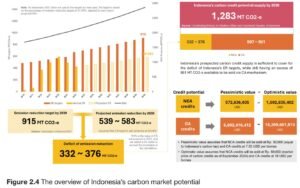Indonesia plans to sell 13.4 billion tonnes of carbon-dioxide equivalent (CO₂e) credits to global buyers. This is one of the biggest carbon market plans in the world. The government says the move could bring in billions of dollars in investment while helping the country meet its climate goals.
The forestry minister’s announcement comes as more countries and companies look to buy verified carbon credits to offset emissions. Experts estimate the global carbon market could grow to $35 billion by 2030, more than five times its current size. With its large forests and renewable energy projects, Indonesia could become a major supplier of these credits.
Building a Global Carbon Market
The 13.4 billion tonnes of CO₂e credits will come from projects that cut or remove carbon emissions. These include forest protection, peatland restoration, renewable energy, and carbon capture programs.
Indonesia has about 125 million hectares of tropical forest, which absorbs over 25 billion tonnes of CO₂e every year. The government sees carbon trading as a way to earn money while protecting the environment.
Officials say this plan could create tens of thousands of green jobs. It will also attract private funding for conservation and clean energy projects.
The credits will be traded through Indonesia’s national carbon registry, the Sistem Registri Nasional (SRN). This system tracks emissions and removals across industries and projects.
The Rise of Carbon Trading at Home
Indonesia launched its own carbon exchange in 2023 through the Indonesia Stock Exchange (IDX). During its first year, it traded about 500,000 tonnes of CO₂e, worth around $5 million.
By 2024, the country had registered more than 2,000 carbon projects, covering areas like energy, forestry, and manufacturing. The government also started a carbon-pricing system for power plants. Large emitters must now report their emissions and offset some of them through credits.
In 2025, Indonesia reopened carbon trading with other countries under new rules aligned with the Paris Agreement. These rules prevent double-counting of emission cuts and make trading more transparent.
However, local carbon prices remain lower than international ones. Indonesia’s credits often sell for under $20 per tonne, while high-quality global credits range from $40 to $80 per tonne. Officials hope international demand will help raise prices closer to global levels.
- SEE MORE: $65 Billion Green Fund from Carbon Credits Sale? Says Indonesia’s President-elect Prabowo Subianto
The Economic and Climate Impact
If Indonesia sells all 13.4 billion tonnes of credits, they could be worth between $130 billion and $670 billion, depending on the market price. Even selling a fraction of this amount would make Indonesia one of the world’s biggest carbon credit exporters.
The program supports the country’s pledge to cut emissions by almost 32% on its own or 43% with global support by 2030. Indonesia also aims to reach net-zero emissions by 2060.

Moreover, the country aims to cut emissions by up to 43% by 2030 with international support. Indonesia’s forests and peatlands store large amounts of carbon; protecting them and trading carbon credits can turn this natural resource into income.
At the same time, the country still burns coal for much of its power, so these credits help raise funds for cleaner energy. Revenue from carbon credit sales will support:
- Forest protection: Deforestation, which once exceeded 1 million hectares per year, has already declined and could fall further.
- Renewable energy projects: Solar, hydro, and geothermal sources now supply about 14% of Indonesia’s power.
- Local communities: Landowners who protect forests and wetlands will earn income instead of clearing them for crops.
These projects link environmental goals with economic growth. They help rural areas gain from the green economy. The Southeast Asian nation has the following pillars in cutting emissions.

Big Buyers, Bigger Ambitions
Many large companies are eager to buy reliable carbon credits. Firms like Microsoft, Shell, and Delta Air Lines have pledged to offset emissions through verified carbon projects.
According to BloombergNEF, demand for nature-based credits could rise from 165 million tonnes in 2024 to over 1 billion tonnes by 2030. If Indonesia supplies even 10% of that, it could sell 100 million tonnes each year and earn around $5 billion annually at moderate prices.
Indonesia’s participation will also help balance global supply, which currently depends mostly on Latin America and Africa. A more diverse carbon market could make prices fairer and more stable worldwide.
Per Sylvera’s report, nature-based credits (ARR) price hit a record high in late 2025. The report shows that buyers are looking for projects that have a verified impact and deliver real results.

Challenges and Verification
Indonesia’s plan faces some key challenges. Experts warn that buyers need strong proof that credits represent real, lasting carbon reductions.
The government is working with certification bodies such as Verra and Gold Standard to verify projects and meet international standards. It will also use digital systems to track every project and transaction.
Some environmental groups worry about “reversal risk.” This happens when forest-based carbon savings are lost later through fires or illegal logging. To prevent this, Indonesia plans to set up a buffer system — keeping some credits in reserve in case of future losses.
The country will also use “corresponding adjustment” rules to ensure every exported credit is subtracted from Indonesia’s national inventory. This keeps its reporting aligned with global accounting standards.
Asia’s Race for Carbon Leadership
The International Energy Agency (IEA) says the world needs to remove or offset 5 to 10 billion tonnes of CO₂ each year by 2050 to meet climate targets. At present, global carbon markets cover less than 1% of that need.
Countries like Indonesia can help fill this gap. The World Bank estimates Southeast Asia could earn $10 billion a year from carbon trading by 2030 if systems are transparent and credible.
Countries like Vietnam and Malaysia are also creating carbon registries. They might open their markets to foreign buyers soon.
Carbon credit exports could make Indonesia a leader in the global green economy. The country could use this income to fund renewable energy, restore ecosystems, and support local livelihoods.

Under government rules, at least 30% of carbon credit revenue must go to local communities and regional governments. This helps support reforestation, sustainable farming, and eco-tourism.
If the plan works, experts say Indonesia could cut up to 2 billion tonnes of CO₂e by 2030. That’s like taking 400 million cars off the road for a whole year.
Promise and Proof: Making Every Credit Count
Indonesia’s offer to sell 13.4 billion carbon credits shows how climate policy and economic growth can work together. The opportunity is huge, but success will depend on strong verification, fair pricing, and transparent reporting.
If done right, the plan could turn Indonesia into one of the top players in the global carbon market. It could also help meet global climate goals while bringing new income to rural areas.
As more nations look for trustworthy carbon credits, Indonesia’s forests and renewables could become valuable global assets. The challenge now is to make sure every credit sold represents real, lasting progress for the planet.
The post Indonesia Aims to Sell 13.4 Billion Tonnes of Carbon Credits to Global Buyers appeared first on Carbon Credits.















